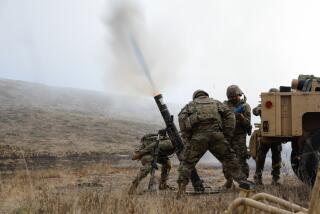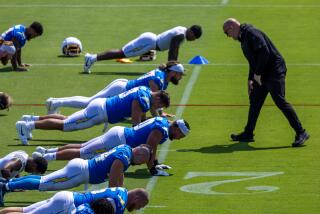Future’s uncertain for historic Marine division headquarters
The United States was newly at war in 1942 when the Marines moved into their new base on Rancho Santa Margarita y Las Flores, a cattle ranch nestled between the Southern California cities of Oceanside and San Clemente.
The coastal location was ideal for a force in need of an amphibious training base. Scores of temporary military buildings were erected.
Today, most of those have either been replaced or remodeled. One from that era, however, remains relatively unchanged — and some of its tenants hope it stays that way long after they’re gone.
The building known colloquially as “the White House” has been the command post of the 1st Marine Division since 1946.
Built in 1943 as a temporary structure, it was intended to stand for five years. Instead it has seen the division through almost every American military engagement since then.
Now the division has outgrown the facility, and a new headquarters is in the works.
But Kelli Brasket, Camp Pendleton’s cultural resources manager and archaeologist, said the base is nominating the original building to be placed on the national register of historic places.
“It’s an early example of the Marine Corps’ growing presence on the West Coast,” she said. “It’s [also] associated with a master architect — Myron Hunt.”
Hunt, whose firm designed many of the base’s early military buildings, is more well-known as the designer of the Rose Bowl in Pasadena.
The two-story-tall White House features a wide, deep porch along its front, old wooden floors creaking under modern carpeting inside and long, narrow hallways on both levels. Brasket calls them “character defining features.”
Artifacts from each major engagement are displayed around the two main staircases, along with photos of every commander in the division’s 78-year history.
The 1st Marine Division is the ground combat element of the I Marine Expeditionary Force. It is the largest and most equipped command in the Marine Corps, according to its commanding general, Maj. Gen. Robert Castellvi.
“When you think of the Marine Corps,” Castellvi said, “you think of the 1st Marine Division and where it all began, here at Camp Pendleton.”
The 1st Marine Division was activated in 1941. It saw heavy fighting in the Pacific theater, notably the battles of Guadalcanal, Peleleu and Okinawa. It deployed during the Korean War, Vietnam, both wars in Iraq and the war in Afghanistan.
Throughout the decades, the division headquarters has remained the same. That’s becoming a problem, Castellvi said.
About 22,000 Marines fall under the command of the division. To manage them and their subordinate commands, Castellvi’s staff is spread out among six buildings on Camp Pendleton.
The White House, with all its charms, just wasn’t built for the demands of a modern military force, he said.
“We’ve made it work,” he said, ”but we now need a better facility.”
Plans for a new headquarters are in their early phases, said Marine Capt. Luke Weaver, a base spokesman, adding that the 1st Marine Division could have a new command post as early as 2024.
As for the White House, people are in the early stages of discussing whether it can become a command museum, Weaver said.
Castellvi said the building represented everything it meant to be a Marine; he hopes it will be preserved.
“When you come to this headquarters it reminds you why you came into the Marine Corps to begin with — to be part of something larger than yourself,” he said. “The history, the legacy, the traditions are embodied by what you see in this building. This place is special.”
Behind the White House, in a bunker that dates back to Vietnam, sits the division’s bar, Matilda’s. It’s where, since 2005, division staff have met every other Thursday afternoon.
Matilda’s is unlikely to make the trip to the new headquarters, said Castellvi.
“We’ll find something suitable,” he said. “Or, we’ll come back to this place. I hope that long after we build a new headquarters that every one of us can come back here and see it preserved in the same way it was.”
Right now, one hurdle to securing a command museum is financial.
Also, there is already a museum on the base, the Marine Corps Mechanized Museum, which features Marines ground vehicles since World War II.
Castellvi said the mechanized museum can be a “template” for transitioning the White House into a museum.
“The 1st Marine Division Assn. is very interested; they’re part of the solution,” he said. “Nobody wants to see ... what some will refer to as the White House go away.”
Dyer writes for the San Diego Union-Tribune.
More to Read
Sign up for Essential California
The most important California stories and recommendations in your inbox every morning.
You may occasionally receive promotional content from the Los Angeles Times.











